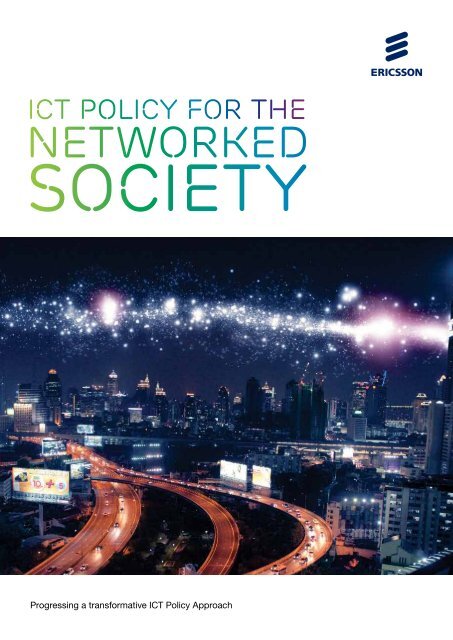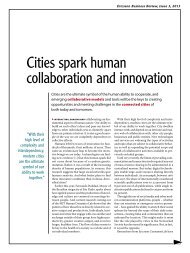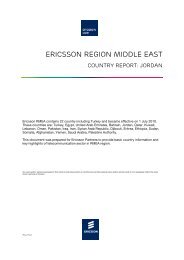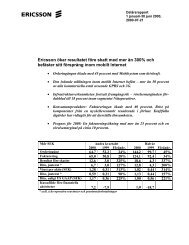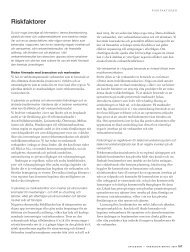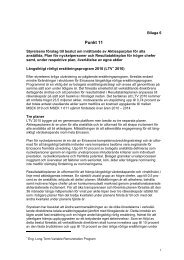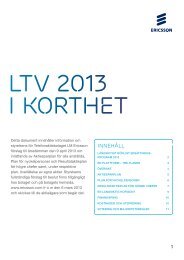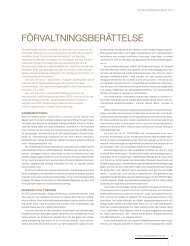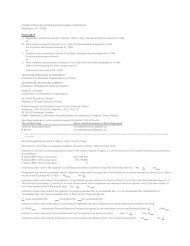ICT Policy For Networked Society - Ericsson
ICT Policy For Networked Society - Ericsson
ICT Policy For Networked Society - Ericsson
You also want an ePaper? Increase the reach of your titles
YUMPU automatically turns print PDFs into web optimized ePapers that Google loves.
<strong>ICT</strong> POLICY for the<br />
<strong>Networked</strong><br />
<strong>Society</strong><br />
Progressing a transformative <strong>ICT</strong> <strong>Policy</strong> Approach
index<br />
Executive Summary ................................................................................................................................................................................................ 5<br />
The role of <strong>ICT</strong> in the society and the economy................................................................................................................................... 6<br />
The emergence of the networked society ................................................................................................................................................ 9<br />
Why regulate? .........................................................................................................................................................................................................10<br />
What ends in mind? - Regulatory objectives .......................................................................................................................................12<br />
How to regulate? ....................................................................................................................................................................................................16<br />
Key global <strong>ICT</strong> policy issues ...........................................................................................................................................................................17<br />
- Spectrum Management ................................................................................................................................................................................18<br />
- Network regulation ...........................................................................................................................................................................................18<br />
- Convergence ........................................................................................................................................................................................................18<br />
- Media/content regulation.............................................................................................................................................................................19<br />
- Copyright ...............................................................................................................................................................................................................19<br />
- Information Management ........................................................................................................................................................................... 20<br />
Conclusions .............................................................................................................................................................................................................. 21<br />
References and suggestions for further reading ............................................................................................................................... 22<br />
3
EXECUTIVE SUMMARY<br />
Over the last 30 years a number of different policy<br />
and regulatory approaches have been used to cope<br />
with the challenges encountered at the time. <strong>For</strong><br />
instance, many countries have moved away from stateowned<br />
telecommunications monopolies and have<br />
adopted liberalization and deregulation to embrace<br />
a market-based regulatory approach that relies on<br />
competition policy.<br />
No regulatory framework (why, what and how to regulate)<br />
comes with a lifetime warranty. Historically, we have<br />
heard calls for less regulation, better regulation, more<br />
equitable regulation, smarter regulation, and now for<br />
more holistic regulation that focuses on the cumulative<br />
impact of regulation. Each of these calls serves as a<br />
reminder that technology moves faster than regulation<br />
and hence there is a continuous need for keeping<br />
regulatory frameworks aligned with technological,<br />
business, consumer, market, and societal realities.<br />
In this context of constant change, it is worthwhile to<br />
remind ourselves that the networked infrastructure that<br />
blends computing and communication is the largest<br />
construction project in human history. [i] It is also useful<br />
to take a “helicopter view” of the transformative role of<br />
information and communications technology, “<strong>ICT</strong>”, in<br />
society and its role in accelerating socio-economic wellbeing.<br />
There is an opportunity cost of a narrow or onesided<br />
policy framework that does not adapt to market<br />
realities and stimulate the contribution that commercial<br />
stakeholders can bring to society. [ii] The strategic<br />
benefits of a prudent, forward-looking <strong>ICT</strong> policy can be<br />
put at risk if policy-makers fail to appreciate the crucial<br />
role of <strong>ICT</strong> in society.<br />
We are at an inflection point of an <strong>ICT</strong>-led transformation<br />
of the society we know today. A new productive shift<br />
in economies is expected with the rise of a networked<br />
society. Developing the strategic capability to master<br />
this change in the most advantageous fashion must be<br />
the key priority for policy-makers. Minimizing the gap<br />
between technology and regulation must take center<br />
stage on the agenda of policy makers. The absolute as<br />
well as relative success of societies and economies of<br />
this largest human project in our history is substantially<br />
determined by policy makers and regulators.<br />
<strong>Ericsson</strong> would like to share its thoughts and ideas on<br />
some of the key elements of a progressive and prudent<br />
future policy and regulatory framework. Nations that will<br />
benefit the most from an <strong>ICT</strong>-led societal transformation<br />
will be those that adhere to a transformative <strong>ICT</strong> policy<br />
approach that is holistic and not sector-specific i.e. a<br />
converged regulatory framework. This relative change<br />
of focus in policy approach fundamentally reflects the<br />
desire of societies and nations to maximize their national<br />
competitiveness of their industries and public sector.<br />
<strong>Ericsson</strong> hopes that this document can be a source of<br />
insight for advancing current policy realities of societies,<br />
economies, businesses, cities and citizens.<br />
5
ThE ROLE Of <strong>ICT</strong> IN<br />
ThE SOCIETY ANd<br />
ThE ECONOMY<br />
A society that has no wheel and no writing is limited in<br />
what it can achieve. Technology has the ability to remove<br />
limitations on individual, organizational and social<br />
action. Some technological advancements not only<br />
transform economies but also lead to structural changes<br />
affecting production, distribution, communication and<br />
consumption in societies. The capacity for structural<br />
change is a highly valuable skill for a nation. It can be<br />
applied in order to stimulate development and then to<br />
preserve and increase the gains as the context and<br />
opportunities change.[iii] The societal skill to master<br />
change is a key strategic capability, as it shapes<br />
competitiveness at the national level. It defines the<br />
capacity of an economy to shift economic activities and<br />
hence output to more productive activities which in turn<br />
can generate higher levels of real wages.[iv]<br />
<strong>ICT</strong> enhances productivity and is a key source of economic<br />
growth, job creation, and new business creation which<br />
leads to an increased tax base. Understanding <strong>ICT</strong>-<br />
induced economic growth beyond the stimulus caused<br />
6<br />
by direct <strong>ICT</strong> investment is crucial. Some important<br />
effects of <strong>ICT</strong> investments on productivity that have<br />
been identified are: [v]<br />
• Improvements in human capital: <strong>ICT</strong> creates demand<br />
for higher skilled labor and eliminates simple and<br />
tedious tasks.<br />
• Multifactor productivity growth, which includes the<br />
impact of intangible investments such as<br />
organizational changes, new distribution and<br />
production processes, and new methods of doing<br />
business related to the use of <strong>ICT</strong> technology.<br />
• <strong>For</strong> every 10 percentage point increase in broadband<br />
penetration the isolated economic effect on GDP<br />
growth is around 1% of GDP, with estimates varying<br />
between 0.5% - 2%.<br />
• <strong>For</strong> every 1,000 additional broadband users, around<br />
80 jobs are created, with estimates varying between<br />
20 and 130.<br />
• Doubling the average attained broadband speed for<br />
an economy increases GDP by 0.3% points.<br />
A n et w or ked cit y can be seen as a combin at ion of<br />
t h r ee pr in cipal societ y sph er es w h er e ict is an<br />
en abl er f or t r ipl e bot t om l in e devel opmen t<br />
Figure 1: A simplified overview of the interdependencies between <strong>ICT</strong> and its effects on society<br />
Improved<br />
economic<br />
output<br />
Energy<br />
consumption<br />
Knowledge<br />
intensity<br />
Effect on<br />
education<br />
City<br />
Effect on<br />
healthcare<br />
Social<br />
interaction<br />
Attraction of<br />
talent<br />
Green<br />
development<br />
Traffic<br />
management<br />
Improved<br />
governmental<br />
finances<br />
Income level<br />
Attraction of<br />
capital<br />
Citizen<br />
Change in<br />
consumer behavior<br />
<strong>Networked</strong><br />
<strong>Society</strong><br />
Attractiveness<br />
Increased usage of <strong>ICT</strong><br />
Improved public<br />
sector efficiency<br />
Emission<br />
levels<br />
Improved private<br />
sector efficiency<br />
Productivity<br />
Employment<br />
Creativity/<br />
innovation<br />
Entertainment<br />
Work place<br />
flexibility<br />
Illustrative and simplified<br />
Change in<br />
industry<br />
mix<br />
Self<br />
fulfillment Business<br />
Private<br />
sector<br />
growth<br />
Investments<br />
in <strong>ICT</strong><br />
Source: <strong>Ericsson</strong> <strong>Networked</strong> <strong>Society</strong> Index 2011
The 21st century is the first digital century! Digitization<br />
is present in all aspects of our lives, including:<br />
communication, information, collaboration, advertising<br />
and media, as well as in retail commerce and banking,<br />
e-commerce, e-/m-payments, and social networking<br />
The digital information revolution is opening up<br />
an amazing array of information for people to get<br />
access to, particularly through the Internet. But to<br />
see the information revolution as principally about<br />
the ability to more easily access text or video<br />
information is to only see the tip of the iceberg.<br />
Information access on the Internet is an amazing<br />
innovation, but the full breadth and depth of the<br />
digital information revolution goes far beyond<br />
Web surfing, for the digital information revolution<br />
is extending to virtually all aspects of our lives, all<br />
parts of society and all organizations. It is only now,<br />
when a vast array of information is in digital form<br />
and when it is far easier and cheaper to create,<br />
manipulate, organize, transmit, store and act on<br />
information that we can truly speak of being in the<br />
digital information age. [vi]<br />
Digitization is a product created by <strong>ICT</strong> industries and<br />
is the key driver of convergence. Wireless and fixed<br />
broadband access is the prime enabler of convergence<br />
as it sets the fundamental conditions and boundaries that<br />
determine how we interact with digital information.[vii]<br />
Within just a few years we have moved from a<br />
communications system that provided us individually with<br />
a mere trickle of information (a few kilobits), to a stream<br />
(megabits over broadband), and soon to a veritable flood<br />
(gigabits of ultra broadband communications). It is the<br />
equivalent of moving from horses, to trains, to personal<br />
automobiles, to personal jets all within a few years. [viii]<br />
Societal transformation led by <strong>ICT</strong> is not just the tale<br />
of the prosperous states doing better. Most developing<br />
countries view the increased use of <strong>ICT</strong> as a critical<br />
tool in their efforts to eradicate poverty, enhance<br />
human development, and achieve the U.N. Millennium<br />
Development Goals. Recognizing this untapped potential,<br />
infrastructure initiatives and development strategies<br />
incorporating <strong>ICT</strong> are being increasingly promoted<br />
and launched. [ix] This movement is known as <strong>ICT</strong> for<br />
development, <strong>ICT</strong>4D. Access to <strong>ICT</strong> and particularly the<br />
Internet can provide an even bigger boost to economic<br />
growth than access to mobile voice service and simple<br />
data such as SMS. However, to make the most of the<br />
Internet, users need to have a certain level of education<br />
and literacy. The Internet’s effect on development may be<br />
greater in the long term, but is unlikely to be as sudden<br />
and dramatic as that of the spread of mobile phones in<br />
the first decade of this century.<br />
Throughout the history of telecommunications, mobile<br />
communication has made a bigger difference to the<br />
lives of more people, more quickly, than any previous<br />
technology. [x] What GSM has done for connecting<br />
voice globally will be repeated by 3G and LTE mobile<br />
technologies for the Internet to truly become a global<br />
network for all. In this sense, there is no contradiction<br />
between these two technologies. Rather, they are<br />
reinforcing each other. The mobile Internet will empower<br />
billions of new users who will not otherwise have the<br />
opportunity to use the Internet. It will create new digital<br />
markets and wealth, enable new business models and<br />
innovation, and enable new forms of social activity and<br />
organization.<br />
7
Understanding the effects and benefits of <strong>ICT</strong> on nations<br />
has been the standard way of analyzing the impact of<br />
<strong>ICT</strong> for decades. However, increasingly the impact of<br />
<strong>ICT</strong> must be understood within a city, business and<br />
citizen framework because doing so allows for more<br />
meaningful comparisons. [xi] If we take the example of<br />
a city framework we can observe the following. Firstly<br />
cities represent a more universally comparable context<br />
compared to the more commonly used nation based<br />
frameworks. Comparing London with Shanghai makes<br />
more sense than comparing the UK with China. Hence<br />
a city focus provides opportunities for a faster learning<br />
and global best practice sharing. Secondly, already<br />
today more than 50% of the world’s population lives<br />
in urban areas and by 2030 the number is expected to<br />
grow above 60%. There is a steady stream of people<br />
moving from the countryside to the cities. The global<br />
urban population increases by over 5 million people<br />
every month, equivalent to the size of Miami or Sydney.<br />
Today more than 20 cities in the world are classified as<br />
8<br />
mega cities with more than 10 million inhabitants. By<br />
the next decade at least eight additional mega cities<br />
will emerge, with half of them located in the developing<br />
countries. [xii]<br />
No matter the path of economic development<br />
a country has chosen, urbanization remains an<br />
inevitable outcome of this effort across the world. [xiii]<br />
Increased urbanization leads to increasing influence for<br />
cities. According to McKinsey Global Institute, the 600<br />
largest cities account for more than 50% of the world’s<br />
GDP but only 22% of the global population. At the<br />
same time it is the medium-sized cities with populations<br />
ranging from 150 thousand to 10 million that are<br />
predicted to account for the largest growth in terms of<br />
GDP up to 2025. This highlights the fact that it is not only<br />
the mega cities that will drive development but many big<br />
cities will take part in shaping society going forward.
ThE EMERgENCE Of ThE<br />
NETwORkEd SOCIETY<br />
Today’s mobile and digital life is expanding into more<br />
areas of society and business. We now stand on the<br />
brink of transformative innovation opportunities across<br />
industries, public service and private life. The digital<br />
revolution that we today can see all around us is based<br />
on the rise of the Internet, broadband, advanced digital<br />
devices and applications. These have given rise to digital<br />
natives and digital organizations that have adopted and<br />
integrated the tools facilitated by the digital revolution.<br />
As a result, they have quite distinct expectations and<br />
behavior compared to their analogue peers.<br />
Over the coming years, <strong>ICT</strong> infrastructure performance<br />
will increase rapidly, fuelled by technology advances. This<br />
will bring new opportunities for people and business to<br />
create, learn, sustain and innovate leading to a positive<br />
impact on our world. <strong>Ericsson</strong> calls this new emerging<br />
society “The <strong>Networked</strong> <strong>Society</strong>”.<br />
In the <strong>Networked</strong> <strong>Society</strong> people, knowledge,<br />
relationships, information and things are networked<br />
for the enhancement of life, businesses and society.<br />
In the <strong>Networked</strong> <strong>Society</strong> the majority of the world’s<br />
population will have grown up with a culture defined by<br />
openness, sharing, networked production/organization,<br />
peer production [see box 1 for more information], and<br />
global self-organization. This will fundamentally change<br />
the way in which we orchestrate capabilities in society to<br />
innovate, to collaborate, to create goods and services, to<br />
govern, and to sustain. Once this social change begins,<br />
it cannot be reversed.<br />
Our world today is at an inflection point. Today people,<br />
enterprises, markets and societies are all benefiting<br />
from real-time connectivity and networking enabled<br />
by broadband. Today, connectivity to the network<br />
everywhere is something taken for granted. Digitization<br />
extends into all possible areas of society and mobility<br />
supports interactions whenever and wherever desired.<br />
With the practices of today’s digital life expanding<br />
into more and more areas of society and business the<br />
<strong>Networked</strong> <strong>Society</strong> will take shape and benefit from<br />
fundamental transformation across industries, public<br />
services and in private life.<br />
Information and communications technology is<br />
converging into a single “social infrastructure” critical<br />
for everyday life and for the continued innovation<br />
to build prosperity in the <strong>Networked</strong> <strong>Society</strong>. Thus<br />
it becomes a common ‘flat’ infrastructure in which<br />
differences in technology are largely invisible either<br />
because they are not relevant to users or because<br />
the infrastructure has an inherent ability to<br />
choose the ‘best’ technology for each purpose.<br />
It adapts to the situation to which the networking<br />
experience currently relates. It provides seamless<br />
connectivity, and application and content<br />
“cross-over”. It minimizes distinction between<br />
different devices and different usage contexts. Services<br />
and content can deliver the ‘feeling’ of seamlessness,<br />
simplicity and comprehensive reach to end-users.<br />
As individuals across the globe today we collectively<br />
share real-time experiences of a digital world hardly<br />
known just a decade ago. The new ways we have<br />
adopted for interaction, sharing of experiences and<br />
knowledge, as well as for sharing innovation are now set<br />
to fundamentally change the way society evolves.<br />
In the <strong>Networked</strong> <strong>Society</strong> things will be made differently,<br />
created with higher efficiency and productivity with new<br />
and enriched experiences. Key traits of the <strong>Networked</strong><br />
<strong>Society</strong> are continuous transformation driven by<br />
collaboration and creativity. Creativity originates in the<br />
interaction between people and businesses and takes<br />
different shapes and forms as it is expressed in the<br />
society we live in. The information age is an input, and<br />
not the outcome along the road towards the transition<br />
to a knowledge society. The <strong>Networked</strong> society is a<br />
knowledge society that knows how to use information.<br />
9
Internal | 2012-03-02 | Page 2<br />
10<br />
BOX 1. NETwOrkEd PrOduCTION & OrgANIzATION: - PrOduCTION NETwOrkS vS. PEEr<br />
PrOduCTION whAT IS ThE dIFFErENCE? [XIv]<br />
In the academic fields of economics and sociology,<br />
networks came to mean a mode of governance that<br />
is different from managerial hierarchies or markets.<br />
The concept of networked organization emerged<br />
within the transactions-cost economics (Coase 1937,<br />
1960 and Williamson 1975, 1985) and was originally<br />
intended to explain the organization of economic<br />
production. The sociologist Walter Powell argued in<br />
a famous paper the break with the transaction-cost<br />
theory. Powell concluded that networks constitute a<br />
distinctive “organizational form” or type of governance<br />
that was neither market nor hierarchy. A network<br />
is a relationship rather than a transaction and it is<br />
based on long term bonds of reciprocity and trust<br />
among economic actors. A more recent, Internetrelated<br />
argument about networked production starts<br />
with the presence of ubiquitous, powerful networked<br />
information technology (Paul Adler, Yochai Benkler). It<br />
then continues, with the availability of this technology<br />
that significantly reduces costs and magnifies the<br />
whY REgULATE?<br />
A regulatory framework consists typically of three key<br />
elements as depicted in figure 2. Its parts aim to answer<br />
the following three questions;<br />
• Why Regulate? – The policy rationale and legitimacy<br />
of interventions.<br />
• With what ends in mind? – What regulatory<br />
objectives and desired outcomes are being pursued?<br />
• How to regulate? – The matching of regulatory<br />
instruments to regulatory objectives and choosing of<br />
implementation strategies.<br />
Figure 2: key elements of a regulatory framework<br />
hOw<br />
regulatory<br />
Framework<br />
whAT<br />
why<br />
Source; <strong>Ericsson</strong>, inspired by weatherill, Better regulation, Oxford<br />
2007 and Prosser, The regulatory Enterprise, Oxford, 2010.<br />
scope of establishing relationships based on the<br />
reciprocal benefits of association, i.e. peer production.<br />
Yochai Benkler, the author of The Wealth of Networks,<br />
has a concept of peer production which is very similar<br />
to Powell’s networked organization. But there is one<br />
important difference. While both recognize the benefits<br />
of reciprocity obtained without a market or a hierarchy,<br />
the roles of trust and depth/strength in relationships<br />
between actors significantly differ between them.<br />
In peer production, relationships are mostly based<br />
on relatively anonymous and automated encounters<br />
with no particular expectation of trust and long-lived<br />
relationships. Trust provides a level of certainty in<br />
planning, execution, performance, cost control (and<br />
hence liability) and above all in receiving cash and noncash<br />
compensation. This single but vital difference<br />
is extremely significant in understanding what to<br />
expect from networked and peered productions or<br />
organizations.<br />
As a starting point one can assume that wealthy<br />
economies can be developed under a variety of policy<br />
and regulatory frameworks. [xv] These economies meet<br />
a threshold of institutional quality that ensures political<br />
and economic stability, reasonable state capacity,<br />
enforcement of property rights and contracts, sufficient<br />
provision of public goods and limits on government<br />
predation and corruption. Weak institutions are not only<br />
an inequitable burden on citizens—they also act as<br />
brake on economic growth by undermining incentives<br />
in the private sector. [xvi] This important aspect of policy<br />
making is beyond the scope of this paper. Instead the<br />
paper assumes that the institutional threshold has<br />
been reached and that legitimacy of policy makers and<br />
regulators is established. This means that the state can<br />
identify relevant regulatory approaches, understand<br />
their key objectives, highlight the importance of<br />
implementation and identify key industry issues. In<br />
present circumstances, the state will do this in the context<br />
of <strong>ICT</strong> policy and will master all necessary elements with<br />
the aims to improve the capability of society to make the<br />
most of the <strong>ICT</strong> led societal transformation with the aim<br />
to maximize the associated expected net benefits.
<strong>For</strong> this paper, we assume that regulatory objectives<br />
and desired outcomes of an intervention are enough to<br />
legitimize the cost of intervention. In other words, the<br />
justification rests on the premise that regulators are<br />
doing the right thing. In addition, one can argue that<br />
legitimacy can be further enhanced if interventions are<br />
effective. That is, they are working as intended and deliver<br />
an adequate net benefit (the cost of an intervention is<br />
sufficiently lower than its benefits).<br />
A related why question is “why” the “why-regulate”<br />
changes over time? There are a number of explanations<br />
[see box 2 for more information] in the academic field of<br />
political economy that aim to answer this question. The<br />
four most recognized theories are variants on: power,<br />
technological determinism, ideas and domestic policy.<br />
All four explanations have important elements but also<br />
have their individual fallings. [xvii]<br />
Recognized economic and social benefits of an <strong>ICT</strong>-led<br />
societal transformation as well as the expected benefits<br />
BOX 2. POlITICAl ECONOmIC ThEOry - why ThE why ChANgES OvEr TImE?<br />
Power: theory focuses on the distribution of global power<br />
of a single power or a power club. The theory puts<br />
focus on the level of alignment of interests, the<br />
incentives and the ability of a power or power club<br />
to advance achievements. The power theory does<br />
not explain what the powerful seeks in terms of<br />
outcomes nor does it recognize the importance of<br />
the decision making process affecting the outcomes<br />
as such.<br />
Technology: is the polar opposite of the power theory.<br />
It assumes that technology has a logic built into it<br />
that dictates the path forward. Important shifts in<br />
technology frontiers alter the costs and benefits for<br />
all stakeholders concerning market opportunities,<br />
competition and regulation. This approach has been<br />
critiqued to be too deterministic and missing the<br />
important role of the society and governments in the<br />
adoption (and rejection) process of new technologies.<br />
Ideas: some stakeholders shape the collective agenda<br />
regarding ideas about cause and effect and about<br />
desirable outcomes. Some ideas emerge and evolve to<br />
of the rising <strong>Networked</strong> <strong>Society</strong> presented above, not<br />
only provide a strong socio-econonmical but also a<br />
technological based justification, i.e. why the whyregulate<br />
must change in a certain direction.<br />
This absolute necessity to continuously adopt regulatory<br />
frameworks as new technology advancements change<br />
the context is also captured in Manuell Castells work:<br />
The dilemma of technological determinism is<br />
probably a false problem, since technology is<br />
society and society cannot be understood or<br />
represented without its technological tools. Yet,<br />
if society does not determine technology, it can,<br />
mainly through the state, suffocate its development.<br />
Or alternatively, again mainly by state intervention,<br />
it can embark on an accelerated process of<br />
technological modernization able to change the<br />
fate of economy and social well-being in a few<br />
years. [xviii]<br />
become powerful enough to sharply redirect policy, goals<br />
and outcomes, or in the words of the French poet Victor<br />
Hugo: “there is nothing more powerful than an idea<br />
whose time has come”. A rights based regulatory<br />
approach is one good example of an idea based<br />
theory explaining shift in policy frameworks.<br />
Domestic politics typically focuses on interest-group<br />
politics or bureaucratic politics. The former puts<br />
emphasis on the privileged position of concentrated<br />
interests because they are well organized and have<br />
higher stakes and hence incentives in shaping<br />
the outcomes compared to the interests of other<br />
stakeholders. The latter, also known as the publicchoice<br />
theory, views public officials as careerpromoting<br />
and power enhancing entrepreneurs who<br />
strive to further they private agendas. Policies and<br />
outcomes reflect conflicts and cooperation among<br />
the bureaucratic players. Both these two theories<br />
are challenged on the basis that top politicians seek<br />
effective control over office and their governments and<br />
need to respond in a competitive election process to<br />
the interests of voters.<br />
11
whAT ENdS IN MINd?<br />
Regulatory objectives.<br />
A number of distinct regulatory approaches have<br />
emerged over time, each with a focus on specific<br />
regulatory goals with certain desired outcomes:<br />
• Market efficiency<br />
• Public interest<br />
• Rights based<br />
• <strong>Networked</strong> governance<br />
• Transformative<br />
It should be noted that in most cases regulators do not<br />
typically pursue just one regulatory objective at any<br />
given point in time, which means that regulators aim<br />
to balance a number of regulatory objectives within a<br />
specific framework such as telecom regulation.<br />
A market efficiency-oriented regulatory approach is<br />
primarily based on competition policy that is focused on<br />
promotion of consumer welfare through maximization<br />
of market efficiency (allocative [xix], productive [xx] and<br />
dynamic [xxi]) and maximization of consumer choice<br />
and thus consumer sovereignty [see box 3 for more<br />
information on efficient markets]. What is understood<br />
with efficiency is the transfer from suppliers to consumers<br />
of qualitative improvements and cost reductions without<br />
12<br />
BOX 3. A PErFECTly EFFICIENT mArkET<br />
A perfectly efficient market is one in which:<br />
a) Consumers and producers have access to all<br />
possible relevant information to base their<br />
decisions on, i.e. market failure ‘information<br />
asymmetry’ is absent.<br />
b) Prices reflect all costs including costs to third<br />
parties, i.e. the market failure ‘externality’ is absent.<br />
c) Firms cannot profitably charge a price in excess of<br />
‘marginal’ cost, i.e. the market failure ‘market<br />
power’ is absent.<br />
d) There is an absence of ‘public goods/services’,<br />
i.e. the market does not have to provide goods<br />
and services whose marginal cost is zero and<br />
whose enjoyment is impossible to exclude<br />
individuals from.<br />
e) There are no ‘missing markets’, i.e. there are no<br />
goods and services absent from the market whose<br />
cost of provision is less than consumers’<br />
willingness to pay.<br />
restricting the market. [xxii] In addition, keeping markets<br />
open to new entry, competition policy can also be seen<br />
as a form of accountability for the exercise of economic<br />
power and hence maximization of consumer choice.<br />
However, opening up markets for more competition<br />
(market liberalization) or keeping markets open to the<br />
extent of protecting competitors, can also restrict<br />
consumer choice, by ending cross-subsidies which have<br />
supported uneconomic services, customer segments or<br />
regions. Liberalization of the fixed telecom market that<br />
started around 1990 constituted a move away from a<br />
public interest regulatory approach to a market efficiency<br />
regulatory approach. The introduction of multiple mobile<br />
spectrum licenses rather than relying on an exclusive<br />
license arrangement and liberalization of fixed telecom<br />
market are two examples of how the market efficiency<br />
approach has entered the grounds of <strong>ICT</strong> policy.<br />
A public interest-oriented policy approach argues that<br />
there are serious limitations to a market efficiency<br />
approach as the latter one treats all citizens equally and<br />
views all citizens solely in their capacity as consumers.<br />
Since we do not come to market as equals, our market<br />
power as consumers is determined by our position in<br />
the existing distribution of wealth and information.<br />
Since no market is perfectly efficient (all markets are<br />
exposed to some degree of market failure(s)) the case<br />
of a regulatory intervention cannot rest only on the<br />
prospect that an intervention will yield an economic<br />
benefit (increased efficiency of the market in question).<br />
A consideration to intervene must also factor in that a<br />
regulatory intervention has a cost and a probability of<br />
regulatory failure. Only when an intervention to correct<br />
a market failure is expected to yield net economic<br />
benefit (benefit of intervention being greater than<br />
the cost of intervention adjusted for probability of a<br />
regulatory failure) should an intervention be considered.<br />
In other words, identification of a market failure should<br />
not lead to the assumption that regulatory failure is<br />
less likely or less costly. This ought to be an open and<br />
empirical question, which needs analysis on a case by<br />
case basis. [xxiii]
This fact determines our ability to satisfy our preferences<br />
in a market. The public interest approach is a move away<br />
from market-based principles and may also imply a<br />
move away from competition policy and a loss of market<br />
efficiency. [xxiv] This move towards increased social<br />
solidarity is based on the idea that the state has a duty<br />
to ensure equal treatment of citizens irrespective of their<br />
economic resources. In <strong>ICT</strong> policy and regulation this<br />
approach is manifested by regulatory interventions that<br />
attempt to ensure equal access for all consumers (urban<br />
and rural) to vital services by requiring geographically<br />
averaged tariffs, rural subsidies, uniform standards of<br />
services across all served areas and requirements on a<br />
certain level of population service coverage.<br />
<strong>Society</strong> values also other aspects apart from simple<br />
maximization of consumer welfare. <strong>Society</strong>-building<br />
relies on the promotion of culture, social values and<br />
national identity. In countries such as Canada, most<br />
of Europe and parts of Asia Pacific like Australia and<br />
New Zealand, regulation of broadcasting services is to<br />
some or a significant extent based on a public service<br />
media principle. Public service is typically associated<br />
with privileged access to scarce resources, limits to<br />
competition and privileged access to state aid financing<br />
or public ownership. Support for a strong public service<br />
media continues to prevail in some jurisdictions while<br />
in others it is almost completely rejected on the claims<br />
of an inefficient monopoly and preference for a market<br />
based solution.<br />
A rights-based regulatory approach is not premised on<br />
a collective view but examines the individual’s rights in<br />
a society or market. The regulatory rationale to protect<br />
some basic rights is less familiar than the competition<br />
or public interest-based rationale. The rights-based<br />
approach starts with the premise that all individuals<br />
have unconditional rights to certain levels of protection<br />
and that some risks may be unacceptable whatever<br />
their benefits. [xxv] The rights-based approach to<br />
regulation can be encountered in a number of different<br />
policy domains, such as human rights, occupational<br />
health and safety, and environmental rights regulation.<br />
There are also private property rights, limitations on<br />
regulators’ rights to expropriate private assets and<br />
procedural rights which are concerned with how public<br />
authorities, regulators, and courts operate. [xxvi]<br />
It is also fair to say that there is some element of overlap<br />
between the public interest and the rights-based<br />
regulatory approaches, particularly in access regimes.<br />
<strong>ICT</strong> policy has a number of touch points with a rightsbased<br />
approach; issues such as data privacy, the right to<br />
be forgotten, net neutrality and open Internet concerns all<br />
contain elements of a rights-based regulatory approach.<br />
The networked governance approach is increasingly<br />
gaining attention especially its applicability in an<br />
international context [see box 4 for more information on<br />
policy challenges in a <strong>Networked</strong> <strong>Society</strong>]. The main idea<br />
with this approach is to find ways to bridge the gaps<br />
between national institutions and the growing number<br />
of policy issues that are becoming global in their nature.<br />
The main focus of this approach is procedural but since<br />
it is also context specific, such as trade- or Internetspecific,<br />
it will also incorporate certain objectives and<br />
desired outcomes, such as harmonization, coherence,<br />
etc. Governance networks combine state and non-state<br />
actors and procedural means for resolving issues to<br />
BOX 4. POlICy ANd rEgulATOry ChAllENgES IN ThE NETwOrkEd SOCIETy [XXvII]<br />
• The global nature of connectivity and the nature of<br />
borderless communication make imposition of<br />
national or territorial interventions more costly.<br />
• The large growth in volume of data communications<br />
and transactions overwhelms the capacity of a<br />
traditional regulatory process in terms of the<br />
ability to collect, process and respond to events<br />
and issues.<br />
• The distributed nature of control, participation and<br />
authority of global communications and connectivity<br />
challenges the territorial approach and sovereignty<br />
of nation states in policy and regulations.<br />
• The interactive nature of the networked society with<br />
dramatically lowered costs and increased capability<br />
for group action will result in new forms of<br />
collaboration and organization of activities,<br />
including those relevant for policy and regulation<br />
(formulation, implementation and enforcement).<br />
13
overcome some of the limitations of governance based<br />
on territorial sovereignty. From an <strong>ICT</strong> perspective,<br />
the ITU’s World Radio Conference, CITEL, APT-WG,<br />
CEPT, ICANN and WTO are examples of networked<br />
governance approaches. From a nation state perspective<br />
a networked governance approach to policy and<br />
regulation contains elements such as multi-stakeholder<br />
participation in consultations, forums that seek to learn<br />
and reach industry consensus, and increased attention<br />
to co-regulation and voluntary industry codes of praxis.<br />
In other words this approach is also applicable in a<br />
territorial context.<br />
A transformative policy is an approach that focuses on<br />
transformation of an industry or a society at large and more<br />
specifically on the conduct of stakeholders in that process<br />
[see box 5 on how innovation and forces of competitive<br />
economy transform firms, industries and societies].<br />
It typically focuses on supply side policy issues i.e.<br />
the stimulation of innovations, R&D and investments in<br />
new technologies and infrastructures, including publicprivate<br />
partnerships. Increasingly there is also a focus<br />
on demand side policy issues i.e. the adoption of new<br />
technologies and applications by various groups of<br />
end users – including consumers, small and medium<br />
enterprises and public authorities. The aim is to enable<br />
innovation: in new products and services; in the market<br />
place, consumer behavior and value; and in organizational<br />
skills, activities and capabilities. In the context of <strong>ICT</strong>,<br />
national digital economy initiatives that focus on the<br />
adoption and use of new technologies serve as good<br />
examples of an increasing focus on the importance of a<br />
transformative policy that aims to disseminate crucial <strong>ICT</strong><br />
technologies to all essential sectors of an economy. The<br />
fundamental objectives of a transformational approach<br />
are to further a society’s capacity for a structural<br />
change in the most advantageous direction and the<br />
ability to preserve and increase the associated gains as<br />
the societal context changes. Some typical key policy<br />
goals are; competitiveness, productivity, competence,<br />
knowledge intensive and sustainable economic growth,<br />
and digital inclusion.<br />
14<br />
Finally, the answer to the question: “with what ends in<br />
mind?” has changed over time and hence we should<br />
expect it to continue to do so. Over time we have<br />
also witnessed an increased regulatory complexity<br />
as concurrent regulatory approaches have been<br />
moulded into coexistence. Their relative influence varies<br />
depending on context, market maturity and jurisdiction.<br />
Often the cumulative impact of regulation is complex<br />
and hard to predict. The situation is further aggravated<br />
by the <strong>ICT</strong>-enabled convergence process facilitated by<br />
digitization and broadband communications between<br />
information, communication, broadcast, media and<br />
entertainment that conflates previously sector-specific<br />
circumstances into one common context. This process<br />
at some stage will call for a policy framework overhaul<br />
a.k.a. converged policy reforms. This is why calls for a<br />
more holistic regulatory approach that reconciles at least<br />
some of the main contradictions that may arise from<br />
different regulatory and sector-specific approaches/<br />
objectives are being heard from time to time.<br />
<strong>Ericsson</strong> believes nations that will benefit the most<br />
from an <strong>ICT</strong>-led societal transformation will do so by<br />
increasingly adhering to a transformative <strong>ICT</strong> policy<br />
approach, which is more holistic and less sectorspecific,<br />
i.e. converged in a regulatory sense. This<br />
change in policy and regulatory approach fundamentally<br />
reflects the desire of societies to maximize their national<br />
competitiveness and the efficiency of their economy,<br />
industries and public sector. Compared to other<br />
regulatory approaches the transformative approach<br />
maximizes the economic and social benefits of an <strong>ICT</strong>led<br />
transformation. The other regulatory approaches<br />
will continue to coexist to certain degrees since some<br />
societal goals and desired outcomes will continue to<br />
be important and relevant in most jurisdictions and are<br />
better served by these regulatory approaches.
BOX 5. CrEATIvE dESTruCTION - ThE ECONOmICS OF TrANSFOrmATIvE rEmAkINg OF FIrmS,<br />
INduSTrIES ANd SOCIETIES<br />
Schumpeter’s process of creative destruction is a<br />
process in which technological advances are the<br />
main source of economic growth and improvement<br />
in the quality of life. Entrepreneurship and dynamic<br />
competition fuel creative destruction [xviii] in a<br />
process that forces firms and industries to streamline<br />
their processes and develop new tools (technology<br />
leapfrogging) to make them more productive. Firms<br />
also have to cope with changing consumer demand<br />
and offer what end-users want at competitive prices<br />
or alternatively lose customers, and eventually fail. The<br />
market’s “invisible hand”—a phrase of Adam Smith—<br />
shifts resources from declining sectors to more<br />
valuable uses as workers, inputs, and financial capital<br />
seek their highest returns.<br />
A society cannot reap the benefits of creative<br />
destruction without accepting that some firms might<br />
be worse off, not just in the short term, but perhaps<br />
forever. At the same time, attempts to soften the harsher<br />
aspects of creative destruction by trying to preserve<br />
firms and jobs or protect industries will ultimately lead<br />
to stagnation and decline, short-circuiting the march<br />
of progress.<br />
While Schumpeter and his followers were occupied<br />
with dynamic vs. static (price) competition and relative<br />
significance of innovation in big vs. small firms,<br />
Christensen in his book “Innovator’s Dilemma” (1997)<br />
concluded that impact from technological change<br />
comes in two significantly different shapes, with<br />
different effects on firms and industries. Technology<br />
advances of the first sort sustained the industry’s<br />
rate of improvement in product performance and<br />
ranged in difficulty from incremental to radical. The<br />
industry’s dominant firms always led in developing and<br />
adopting these technologies. By contrast, innovations<br />
typically by non-incumbents (e.g. start-ups or from<br />
incumbent firms in adjacent industries) of the second<br />
sort disrupted or redefined performance trajectories<br />
- and consistently resulted in the failure of the<br />
industry’s leading firms. In other words, technological<br />
transformation is definitely not only about big vs. small<br />
and static vs. dynamic but even more about the kinds<br />
of innovations that are introduced to the market and<br />
how these technologies streamline operations, create<br />
new tools, enable new business models and create<br />
new business opportunities in relation to continuously<br />
changing end user demands.<br />
15
hOw TO<br />
REgULATE?<br />
It is obvious from above that there is no one-size fits all<br />
approach to regulate <strong>ICT</strong> but rather that a number of<br />
different regulatory objectives and goals are important in<br />
different situations, times and jurisdictions. Legitimizing<br />
the interventions and their associated goals in a given<br />
context requires a convincing justification. This aspect of<br />
policy making is a complex and sometimes controversial<br />
matter that will continue to consume policy makers’,<br />
regulators’ and other stakeholders’ attention. Given<br />
that this challenge has been adequately addressed, the<br />
next obvious question is “how to regulate?” However<br />
this challenge is to some degree more straightforward<br />
and can be more objectively analyzed on the merits of<br />
identifiable facts.<br />
Much of the discussion on policy and regulation has<br />
historically been concerned with the formulation phase<br />
of policy and regulation, the why and what. However,<br />
increasingly attention has been paid to implementation<br />
of policy and regulation. [xxix] That is, making the choice<br />
and design of regulatory instruments and the degree<br />
of appropriate targeting of these instruments to the<br />
regulatory objectives and ultimately about achieving<br />
desired outcomes. The focus on implementation<br />
and enforcement has also put more pressure on the<br />
formulation phase to more clearly define the primary<br />
objectives of a policy intervention.<br />
It is important that the implementation phase includes<br />
an economic analysis of all relevant implementation<br />
options. This should not be limited to assessment of<br />
administrative costs. Instead it should assess all of the<br />
associated implementation costs that will be borne by<br />
public administrations as well as the market; businesses<br />
and/or consumers and/or society. Finally, the concept of<br />
regulatory failure requires attention by policy makers and<br />
regulators. The risk of a regulatory failure should be taken<br />
every bit as seriously as a risk of a market failure. [xxx]<br />
Most stakeholders accept that the method of<br />
implementing regulation need not be confined to the<br />
conventional top-down command and control type of<br />
implementation strategy. Every single implementation<br />
strategy and every single regulatory tool has its own<br />
strengths and weaknesses and none of them is sufficiently<br />
flexible and resilient to successfully address all relevant<br />
issues in all possible contexts. Four types of regulation<br />
implementation strategies have been identified offering<br />
distinct routes to implement regulation. [xxvii]<br />
16<br />
These routes are not mutually exclusive and provide<br />
a regulatory choice. [xxxi] These are:<br />
• Law/Hierarchy<br />
• Social Norms/Community<br />
• Market/Competition<br />
• Architecture (or code)/Design<br />
A famous example to illustrate these modes states:<br />
…the government may want citizens to wear<br />
seatbelts more often. It could pass a law to<br />
require the wearing of seatbelts (law regulating the<br />
behavior directly). Or it could fund public education<br />
campaigns to create a stigma against those who do<br />
not wear seatbelts (law regulating social norms as<br />
a means to regulate behavior). Or it could subsidize<br />
insurance companies to offer reduced rates to<br />
seatbelt wearers (law regulating the market as a<br />
way of regulating the behavior). Law could mandate<br />
automatic seatbelts or ignition blocking systems<br />
(changing the architecture or code of the automobile<br />
as a means of regulating behavior). [xxxii]<br />
Finally, the regulatory process needs to be considered as<br />
a whole – formulation, implementation and enforcement.<br />
The implementation strategies however face the<br />
additional challenge associated with the separation of<br />
regulatory process from regulatory content. Both process<br />
and content will continue to be important. [xxxiii] In other<br />
words, a perfect process cannot compensate for poor<br />
quality of regulatory content. The challenges associated<br />
with agency dilemma [xxxiv], institutional (dis)incentives<br />
and the level of competence of a regulator still apply.<br />
The OECD has been working over the last two decades<br />
on providing advice on how to improve the quality of<br />
a regulatory process and provides us with seven main<br />
regulatory improvement tools: [xxxv]<br />
• Regulatory impact assessment<br />
• Consultation and transparency<br />
• Reduction of administrative burdens and red tape<br />
(i.e. regulatory simplification)<br />
• Enforcement guidelines<br />
• Alternatives to traditional top down implementation<br />
strategies (self-regulation, market-based<br />
instruments, standards, etc )<br />
• Sunset provisions<br />
• Regulatory policies and reviews
kEY gLObAL <strong>ICT</strong><br />
POLICY ISSUES<br />
<strong>Ericsson</strong>’s view on some key global <strong>ICT</strong> issues areas are<br />
given in the following;<br />
• Spectrum Management<br />
• Network Regulation<br />
• Convergence<br />
• Media/Content Regulation<br />
• Copyright<br />
• Information Management (such as data privacy and<br />
cyber security)<br />
These issues have significant impact on R&D investments<br />
and innovation in <strong>ICT</strong> technologies. They affect the cost,<br />
performance and capability of new <strong>ICT</strong> technologies.<br />
A number of <strong>ICT</strong> sectors such as telecom, broadcast,<br />
media, entertainment, software and Internet online<br />
platforms exhibit similar economic realities of high fixed<br />
costs, low marginal costs, economies of scale and network<br />
effects, and hence all face similar investment risks and<br />
uncertainties. Furthermore, these policy issues impact<br />
the timing and scale of the willingness to invest in <strong>ICT</strong><br />
hardware, software and applications. They also determine<br />
end users’ ability to benefit from the use of <strong>ICT</strong>-based<br />
services as these policy issues define the speed, scale and<br />
intensity of <strong>ICT</strong> services adoption.<br />
17
Spectrum management.<br />
<strong>Ericsson</strong>’s positions for each issue including a brief<br />
introduction is provided below; detailed information on<br />
each specific issue can be provided on request.<br />
To identify new spectrum bands in the ITU and license<br />
them nationally is a ten-year process. The work carried<br />
out by regional bodies, such as CEPT for Europe, CITEL<br />
for the Americas, the Asia Pacific Telecommunity and the<br />
African Telecommunication Union lays the foundations for<br />
the introduction of products with standardized connectivity<br />
that can meet the requirements of businesses and<br />
consumers with respect to performance and affordability.<br />
The policy goals of global and regional harmonization<br />
efforts should be to enable:<br />
• Economies of scale<br />
• Easy cross-border coordination<br />
• Cross-border operation<br />
• Global roaming capabilities<br />
• Interoperability, choice and affordability<br />
• Efficient use of spectrum, also in border areas<br />
• Maximizing the economic and societal benefits of<br />
spectrum usage<br />
Network regulation.<br />
Investments in network infrastructure are long-term,<br />
large-scale undertakings that rely on confidence in the<br />
existence of stable market rules that stimulate such<br />
investments and the usage of broadband services. A<br />
typical national network costs billions of € to deploy and<br />
maintain, and has a payback time that can be greater<br />
than a decade. The continuous technological evolution<br />
gradually risks making past investments obsolete.<br />
Network investments are also upfront heavy, irreversible<br />
and once deployed the investments exhibit sunk cost<br />
characteristics. National market rules differ between<br />
countries due to legacy concerns. Active infrastructure<br />
competition should however be promoted as the primary<br />
tool to achieve competition in the provision of and usage<br />
of broadband services. In some situations open access<br />
publicly financed network deployments are necessary to<br />
change the dynamics of a market and/or to compensate<br />
for market characteristics such as low population<br />
density. Global standards should be the basis for all<br />
regulatory measures.<br />
Consumer and property rights need to be respected<br />
and should be balanced. Consumers should be entitled<br />
to access the lawful Internet content of their choice<br />
and run applications and services of their choice that<br />
comply with the terms of their service plans, including<br />
bandwidth limits and quality of service considerations,<br />
so long as it does not harm the network.<br />
18<br />
Network operators must be allowed the commercial<br />
freedom to offer tiered service plans in a competitive<br />
market and to tailor service offerings to meet consumer<br />
demands. Network operators must be permitted to<br />
employ transparent, reasonable, competitively neutral<br />
network management techniques, which may include<br />
prioritization or differentiation of classes of traffic, and to<br />
otherwise adjust network resources to ensure coverage,<br />
quality of service, and quality of consumer experience.<br />
Network Neutrality principles should not apply to<br />
competitive wireless networks since these are subject<br />
to capacity constraints due to varying demand and<br />
limitations in spectrum availability which have significant<br />
implications on network performance.<br />
Convergence.<br />
Convergence is a process that breaks up existing vertical<br />
service-specific value chains and technologies into a<br />
multitude of horizontal service offerings. Convergence is<br />
about services and about new ways of doing business<br />
and of interacting with society. [xxxvi] This technologically<br />
driven process can be understood by considering the<br />
new possibilities it brings to end-users, businesses and<br />
society. Convergence changes markets by transforming<br />
industry sectors, blurring historical market boundaries,<br />
changing the composition and range of possible<br />
market offerings and challenging the robustness of<br />
previously successful business strategies. From a policy<br />
perspective, converges enables increased demandside<br />
and/or supply-side substitution that can ultimately<br />
deliver more choice, competition and innovation.<br />
In a converging environment, a regulatory framework<br />
that treats similar services differently, for example on the<br />
basis of the technical platform, leads to inconsistencies<br />
and uncertainties that limit substitution. This prevents<br />
the market from fully benefiting from the opportunities<br />
provided by technological progress. A vertical and sectorspecific<br />
regulatory approach in an increasingly converged<br />
business environment amplifies the risk for unintended<br />
and dysfunctional market outcomes, suboptimal resource<br />
utilization and decreasing end-user value. <strong>Policy</strong> makers<br />
should increasingly consider a technology-neutral<br />
framework that treats the underlying platforms equally.<br />
Furthermore, as a principle the starting point of a<br />
regulatory implementation strategy should be the service<br />
in question not the platform that delivers the service. This<br />
should not be interpreted as a need to regulate all services<br />
but rather that those that do need to be regulated should<br />
be so based on the justification and desirability of certain<br />
goals and outcomes. The implementation strategy should<br />
be service-specific rather than platform-specific.
media/Content regulation.<br />
A multi-platform audiovisual policy approach needs to<br />
recognize the fast-growing availability and accessibility<br />
of audiovisual content in an environment with various<br />
complementary and alternative networks. In a multiplatform<br />
environment, the same rules and principles<br />
should apply to all technologies and distribution<br />
platforms. Media policy regulation should be technologyneutral<br />
and platform-independent. In other words,<br />
regulation of audiovisual media services should function<br />
irrespective of the underlying platform or means of<br />
distribution.<br />
The key elements that need to be present in a multiplatform<br />
approach are:<br />
• Support of open industry-wide standards for IP<br />
based media distribution via Set-Top Boxes,<br />
Connected TVs and IPTV.<br />
• A platform-neutral approach to regulation of<br />
audiovisual services.<br />
• Clear definitions of what constitutes an audiovisual<br />
service and a definition of audiovisual media service<br />
providers, along with a delineation of their<br />
responsibilities and obligations.<br />
• Mechanisms for fairly managing the competition<br />
within audiovisual distribution markets with tools that<br />
ensure the efficiency of program/content aggregation<br />
for the distribution market.<br />
• Copyright reforms that unlock barriers to multi<br />
platform, anytime, anywhere digital distribution.<br />
Internet content regulation is increasingly becoming a<br />
contentious issue. All regions and nations have their<br />
different norms, systems, values and sensitivities.<br />
When these norms are challenged by the progress of<br />
technology or development in society a rights-based<br />
policy approach typically challenges the established<br />
views. In addition, media convergence is another related<br />
development sometimes confused with Internet content<br />
regulation. However, converged media regulation is<br />
focused on the issue of how to systematically regulate<br />
the different types of professionally produced content<br />
classes in a converged environment: entertainment,<br />
current affairs reporting and cultural works. In this case<br />
the issue of editorial responsibility of a professional<br />
media publisher is of main concern. While Internet<br />
content regulation is fundamentally about free speech,<br />
the level of legitimate individual responsibility of a citizen<br />
(that is, legitimate limitations to free speech) and the level<br />
of expected responsibility of intermediaries enforcing<br />
these limitations are some examples of key concerns.<br />
Copyright.<br />
A revision in most countries of the current digitally<br />
restrictive copyright approach offers a unique<br />
opportunity for nations to set and lead by example. This<br />
is an opportunity that should not be missed. Through<br />
National Digital Agendas, policy makers can update<br />
the current state of play in the digital creative market<br />
by tearing down key structural barriers to making lawful<br />
(licensed and exempt) digital content widely available in<br />
an appealing, timely and user-friendly way.<br />
<strong>Policy</strong> makers need to address some of the fundamental<br />
barriers that hinder the possibility to reap and share the<br />
digital productivity and creativity gains that societies<br />
need. It is time to tear down barriers and solve the<br />
market supply failure of lawful (licensed and exempt)<br />
digital content. This failure is caused mainly by three<br />
structural barriers:<br />
• Limited availability of lawful digital content caused by<br />
“windowing”, exclusive licensing and territoriality<br />
Windowing refers to selling and re-selling products<br />
over time using various distribution channels, for<br />
example the film industry using cinemas, home<br />
video, rentals, cable, video-on-demand, and free-to<br />
air broadcasting.<br />
• Technology-specific copyright conditions including<br />
licensing, exceptions, safe harbors and exhaustion<br />
that limits or delays innovation of new services.<br />
• Unreasonable transaction costs make digital content<br />
unnecessarily expensive.<br />
A competitive and consumer-friendly digital content<br />
market and an appropriate legal framework to enable<br />
easy lawful (licensed) access to digital content are<br />
essential preconditions for the creation of a culture of<br />
lawful, rather than unlawful, consumption. Copyright<br />
enforcement policy should be developed from a clear<br />
evidence-based approach that is:<br />
• Fact-based.<br />
• Balanced to include all relevant stakeholders.<br />
• Focused on end-user demand.<br />
• Respects the right to privacy and freedom<br />
of communication.<br />
• Supports continued innovation in new technologies<br />
and services.<br />
• Promotes growth of lawful licensed digital services,<br />
and market efficiency.<br />
• Respects the relative nature of property rights such<br />
as copyright.<br />
• Avoids outsourcing, e.g. to ISPs, of private<br />
property enforcement.<br />
19
Information management.<br />
The value of information as well as its strategic risks, such<br />
as cyber security, rises with the growth of broadband<br />
networks and the expansion of attention economy [see<br />
box 6]. This value/risk is amplified by the use of networked<br />
applications offered on a multi-territorial basis, such as<br />
social networking, cloud architectures and proliferation<br />
of access points. This leads to a need for coherent<br />
analysis of the roles, relationships, responsibilities and<br />
liabilities of all involved stakeholders:<br />
• End–users: consumer, businesses and<br />
public authorities.<br />
• Service providers: controllers of information<br />
and its use.<br />
• Data/information processors, including cloud<br />
providers, and<br />
• Technology providers.<br />
20<br />
BOX 6. ATTENTION ECONOmICS<br />
The rapid growth of information causes scarcity<br />
of attention:<br />
“...in an information-rich world, the wealth of information<br />
means a dearth of something else: a scarcity of whatever<br />
it is that information consumes. What information<br />
consumes is rather obvious: it consumes the attention<br />
of its recipients. Hence a wealth of information creates a<br />
poverty of attention and a need to allocate that attention<br />
efficiently among the overabundance of information<br />
sources that might consume it” [xxxvii]<br />
From a consumer perspective information management<br />
has been concerned with issues like spam, data privacy,<br />
identity theft and Internet bullying. From a national<br />
security perspective, cybercrime, such as phishing,<br />
trade with counterfeited and stolen goods, corporate<br />
espionage, botnets and DoS (Denial of Service) attacks<br />
pose threats to commercial and civic society. Enduser<br />
confidence in using networked applications is<br />
crucial and hence consumer protection will become<br />
even more essential. Keeping the emerging <strong>Networked</strong><br />
<strong>Society</strong> sufficiently secure will require new approaches<br />
to criminal enforcement that can deal with cyber<br />
security problems that can be highly scalable, difficult<br />
to trace, distributed across multiple territories and often<br />
exceeding the capacity of national approaches.<br />
The fundamental idea behind the attention economy<br />
is to facilitate a marketplace where consumers agree<br />
to receive services in exchange for their attention. The<br />
ultimate purpose is of course to sell something to the<br />
consumer, but the selling does not need to be direct<br />
and does not need to be instant. The most important<br />
factor in attention economy is relevancy. The more one<br />
knows about consumers the more relevant and hence<br />
successful one can be in the attention economy.<br />
“Personal data is the new oil of the Internet and the new<br />
currency of the Digital World.” [xxxviii]
CONCLUSIONS<br />
The networked infrastructure that blends computing<br />
and communication is the largest construction project<br />
in human history. We are at an inflection point where a<br />
significant change in competitive opportunities of nations,<br />
industries, firms and cities is expected. The emergence of<br />
a <strong>Networked</strong> <strong>Society</strong> holds the promise of an economic<br />
shift and of significant societal benefits. This is possible<br />
if we can adopt national and global policies and create a<br />
regulatory framework that can accommodate and<br />
nurture this desired change.<br />
In this context, as policy makers and regulators take<br />
on some of the key issues, such as spectrum, network<br />
regulation, media regulation and convergence, some<br />
crucial questions will continue to be at the center<br />
stage of national and global <strong>ICT</strong> policy and regulatory<br />
development:<br />
• Why Regulate? – The policy rationale and legitimacy<br />
of interventions.<br />
• With what ends in mind? – Regulatory objectives and<br />
desired outcomes being pursued.<br />
• How to regulate? – The matching of regulatory<br />
instruments to regulatory objectives and choice of<br />
implementation strategy.<br />
The constantly changing market and business<br />
conditions mean that <strong>ICT</strong> policy and regulatory<br />
frameworks (why, what, how) must also continue to<br />
evolve to reflect new realities, and to allow the potential<br />
offered by the constant influx of new <strong>ICT</strong> innovations<br />
and developments to be realized. No successful<br />
policy framework comes with a lifetime warranty. In<br />
the continuously ongoing transformation process,<br />
the least desirable outcome of an <strong>ICT</strong> policy framework<br />
would be the protection and conservation of the past<br />
and a delay of the future.<br />
To master the societal change of an <strong>ICT</strong>-led transformation<br />
in the most advantageous direction, future <strong>ICT</strong> policy<br />
and regulatory frameworks will need to carefully consider<br />
how they shape the structures of industries, the conduct<br />
of stakeholders and how they set in motion major shifts<br />
in economic value. Increasingly, a conventional supply<br />
side policy focus will also have to be complemented<br />
with demand-side policy considerations – e.g. the<br />
adoption process of new technologies and applications<br />
by various groups of end-users – including consumers,<br />
small and medium enterprises and public authorities.<br />
This adoption enables innovation in new products and<br />
services, innovation in the market place, new consumer<br />
behavior and value, and innovation in organizational<br />
skills, activities and capabilities.<br />
<strong>Ericsson</strong> believes that an <strong>ICT</strong> policy approach that<br />
not only recognizes but also elevates the strategic<br />
importance of <strong>ICT</strong> technologies will enable nations and<br />
societies to master the ongoing transformation in the<br />
most advantageous way and thereby enable a distinct<br />
and sustainable productive shift in their economies.<br />
This will release all of the associated positive benefits<br />
and <strong>Ericsson</strong> therefore believes that the future <strong>ICT</strong><br />
policy approach should shift towards a transformative<br />
approach which is more holistic and less sector- specific.<br />
This relative change of gravity in policy approach<br />
fundamentally supports the desire of societies and<br />
nations to maximize their national competitiveness to the<br />
benefit of their economy, industries and public sector.<br />
21
EFErENCES ANd SuggESTIONS FOr FurThEr rEAdINg<br />
i Cowhey and Aronson, Transforming Global Information and Communication Market, the Political Economy<br />
of Innovation, 2009.<br />
ii A policy framework includes following elements: a) formulation of legitimacy of a regulator and<br />
interventions (why regulate) b) clear specification of regulatory goals and objectives (what ends in mind) and<br />
c) how to best target regulatory instruments with regulatory objectives (how to regulate?). It also includes<br />
all phases of a policy/regulatory process; policy definition, policy design, implementation, enforcement<br />
and policy review.<br />
iii Carlota Perez, Technological Revolutions and Financial Capital, chapter 2, 2005.<br />
iv Stephen Cohen et al. Global Competition: New Reality vol. 3 of John Young Competitiveness: the Report<br />
of the President’s Commission on Industrial Competitiveness, Washington DC, 1985.<br />
v The literature is enormous for some prominent examples see; Wired <strong>For</strong> Innovation – How IT is Reshaping<br />
the Economy, Brynjolfsson and Saunders; MIT 2010. The Economics of the Digital <strong>Society</strong>, Soete and<br />
Wheel, 2005. The Rise of the Network <strong>Society</strong>, Second Edition, Castells 2010. Boston Consulting Group,<br />
Socio-economic impact of allocating 700 MHz band to mobile in Asia Pacific, 2010, EPC/Copenhagen<br />
Economics –The Economic Impact of a European Digital Single Market, 2010. ADL, Socioeconomic impact<br />
of broadband network investments, 2010. See also http://www.ericsson.com/news/1550083 <strong>Ericsson</strong><br />
Press Release: “New study quantifies the impact of broadband speed on GDP”.<br />
vi Digital Quality of Life, October, ITIF, page 3, 2008.<br />
vii To read more about digitalization and <strong>ICT</strong> technology advancements, see for example: Competing for the<br />
Future- how digital innovations are changing the World, Henry Kressel, 2007.<br />
viii TV or not TV - Three Screens one Regulation?, Eli M Noam, 2008. http://www.crtc.gc.ca/eng/media/<br />
noam2008.htm<br />
ix <strong>ICT</strong> <strong>Policy</strong> <strong>For</strong>mulation and e-Strategy Development U.N. DP, Asian-Pacific Development Information<br />
Programme, 2005<br />
x The Economist, Finishing the Job, 24th of September 2009.<br />
xi <strong>Ericsson</strong>’s <strong>Networked</strong> <strong>Society</strong> City Index, Triple bottom line effects of accelerated <strong>ICT</strong> Maturity in world<br />
wide Cities, 2011.<br />
xii World’s top global mega trends to 2020 and implications to business, society and cultures , Frost &<br />
Sullivan<br />
xiii UN-habitats, State of the World cities 2010/2011<br />
xiv Source: Networks and States, The global politics of internet governance, Mueller, 2010.<br />
xv To offer a precise definition is to risk arguments at the margin. <strong>Policy</strong> and Regulation are used<br />
interchangeably, with a broad meaning; policy/regulation is the sustained and focused attempt to alter the<br />
behaviour of others according to defined standards or purposes with the intention of producing a broadly<br />
identified outcome or outcomes, which may involve mechanisms of standard-setting, information gathering<br />
and behaviour modification. <strong>For</strong> further reading see: Regulation: Legal <strong>For</strong>m and Economic Theory, Ogus,<br />
1994. Also the relation between regulation and legislation is relevant to address. If regulation is about<br />
altering behaviour, then legislation is a subset of regulation. On the other hand, to the extent that regulation<br />
does not encompass task such as constitution making and dispute-resolution the law is broader than<br />
regulation, in other words law and regulation intersect with one another but are not co-extensive. <strong>For</strong> further<br />
reading: Rights, Regulation, and the Technological Revolution, Brownsword page 7, 2008.<br />
xvi The World Bank <strong>Policy</strong> Research: A Historical Overview, Jean-Jacques Dethier, 2009<br />
xvii Transforming Global Information and Communication Markets, the Political Economy of Innovation,<br />
Cowhey and Aronson, 2009.<br />
xviii Manuel Castells, The Rise of the <strong>Networked</strong> <strong>Society</strong>, Second Edition, page 5-7, 2010<br />
22<br />
xix Allocative efficiency: a situation when conditions of perfect competition prevail and where goods and<br />
services are allocated between consumers according to the price they are prepared to pay and price never<br />
rises above the marginal cost of production. (Some times also called static efficiency)<br />
xx Productive efficiency: a situation when as little of society’s wealth is expended in the production of<br />
goods as necessary, so goods are produced at the lowest possible cost. (the emphasis in on the internal<br />
management of a firm’s resources)<br />
xxi Dynamic efficiency: refers to market conditions that appropriately balance short run concerns (allocative<br />
static efficiency) with concerns in the long run (focusing on encouraging research and development).<br />
Through dynamic efficiency, an economy is able to further improve efficiency over time by making<br />
investments in R&D, Education and Innovation that act as forms of new market and demand discovery.<br />
xxii Further reading see, Chicago School literature and its influence on US Antitrust law, Amato (1997)<br />
Bork (1993).<br />
xxiii Financial Risk Outlook, London Financial Services Authority, C McCarthy 2005.<br />
xxiv <strong>For</strong> more expanded discussion see for example: The limits of competition law, markets and public<br />
services, Prosser, 2005<br />
xxv <strong>For</strong> further reading see; Rights, Regulation and the Technological Revolution, Brownsword, 2008 and<br />
The Intersection of Rights and Regulation, Morgan, 2007.<br />
xxvi After the Rights Revolution – Reconceiving the Regulatory State, Sunstein, 1990.<br />
xxvii Inspired by: Networks and States, The Global Politics of Internet Governance, Mueller, 2010.<br />
xxviii Originally the term creative destruction was derived from Marxist economic theory, The Communist<br />
Manifesto, Marx & Engels 1848 and later in “Das Kapital” 1863. However the term has been popularised by<br />
John Schumpeter who further developed the concept in his theory of economic innovation in “Capitalism,<br />
Socialism and Democracy” (1942).<br />
xxix To get an overview of the state of the art of the Public <strong>Policy</strong> Implementation Research an Introduction<br />
to the Study of Operational Governance; Hill and Hupe, Implementing Public <strong>Policy</strong>, 2009.<br />
xxx Better Regulation, Weatherill, page 7 and 58, 2007.<br />
xxxi Controlling the New Media, Hybrid response to New <strong>For</strong>ms of Power, Murray & Scott, 2002 and The<br />
Regulation of Cyberspace, Murray 2007.<br />
xxxii Code and other Laws of Cyberspace, Lessing, chapter 7, 1999<br />
xxxiii Better Regulation, Weatherill, 2007.<br />
xxxiv Principal–agent problem or agency dilemma treats the difficulties that arise under conditions of<br />
incomplete and asymmetric information when a principal hires an agent, such as the problem of potential<br />
moral hazard and conflict of interest, in as much as the principal is—presumably—hiring the agent to pursue<br />
the principal’s interests. <strong>For</strong> more information: http://en.wikipedia.org/wiki/Principal%E2%80%93agent_<br />
problem<br />
xxxv The reference list is extensive, some examples see: OECD, Regulating Policies in OECD Countries,<br />
2002. OECD, Improving the quality of government regulation OECD 1995, OECD Regulatory Reform OECD<br />
1997, OECD Regulatory Impact Analysis, OECD 1997.<br />
xxxvi EC Green Paper on the convergence of the Telecommunication, Media and Information Technology<br />
sectors and the implications for regulation, COM (97)623.<br />
xxxvii Herbert Simon, “Designing Organizations for an Information-Rich World” 1971 pp 40-41.<br />
xxxviii Maglena Kuneva, European Consumer Protection Commissioner, March 2009.
ABOuT ErICSSON<br />
<strong>Ericsson</strong> is the world’s leading provider of communications technology and services. We are enabling the<br />
<strong>Networked</strong> <strong>Society</strong> with efficient real-time solutions that allow us all to study, work and live our lives more freely, in<br />
sustainable societies around the world.<br />
Our offering comprises services, software and infrastructure within Information and Communications Technology<br />
for telecom operators and other industries. Today more than 40 percent of the world’s mobile traffic goes through<br />
<strong>Ericsson</strong> networks and we support customers’ networks servicing more than 2 billion subscribers.<br />
We operate in 180 countries and employ more than 100,000 people. Founded in 1876, <strong>Ericsson</strong> is headquartered in<br />
Stockholm, Sweden. In 2011 the company had revenues of SEK 226,9 billion (USD 35.0 billion). <strong>Ericsson</strong> is listed on<br />
NASDAQ OMX, Stockholm and NASDAQ, New York stock exchanges.<br />
Internal: https://ericoll.internal.ericsson.com/sites/GIR-Government_and_Industry_Relations/Wiki/<strong>ICT</strong>%20policy.aspx<br />
The content of this document is subject to revision without<br />
notice due to continued progress in methodology, design and<br />
manufacturing. <strong>Ericsson</strong> shall have no liability for any error or<br />
damage of any kind resulting from the use of this document<br />
Telefonaktiebolaget LM <strong>Ericsson</strong><br />
SE-126 25 Stockholm, Sweden<br />
Telephone +46 8 719 0000<br />
Fax +46 8 18 40 85<br />
www.ericsson.com © Telefonaktiebolaget LM <strong>Ericsson</strong> 2012


